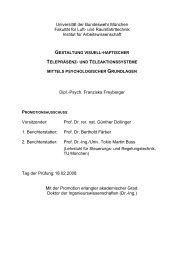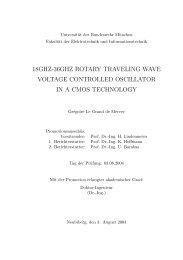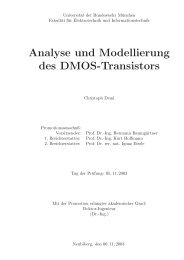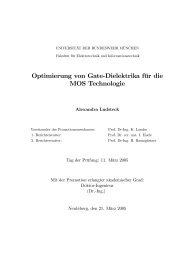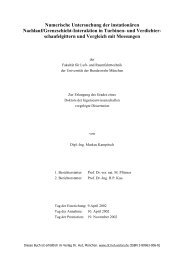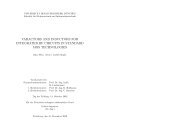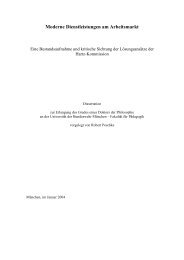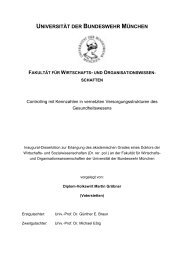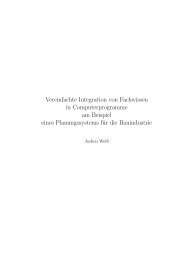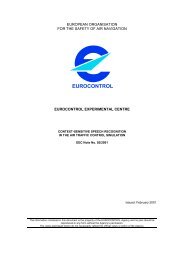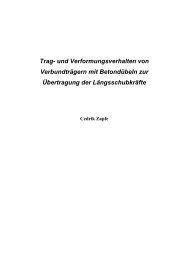Precise Orbit Determination of Global Navigation Satellite System of ...
Precise Orbit Determination of Global Navigation Satellite System of ...
Precise Orbit Determination of Global Navigation Satellite System of ...
Create successful ePaper yourself
Turn your PDF publications into a flip-book with our unique Google optimized e-Paper software.
Chapter 6 Algorithms <strong>of</strong> <strong>Orbit</strong> <strong>Determination</strong> <strong>of</strong> IGSO, GEO and MEO <strong>Satellite</strong>s<br />
�<br />
k1= f( tn, yn)<br />
�<br />
�<br />
4 4h<br />
k2 = f( tn + h, yn<br />
+ k1)<br />
�<br />
27 27<br />
�<br />
2 h<br />
�<br />
k3 = f[ tn + h, yn<br />
+ ( k1 + 3k2)]<br />
�<br />
9 18<br />
�<br />
1 h �<br />
k4 = f[ tn + h, yn<br />
+ ( k1 + 3k3)]<br />
�<br />
3 12<br />
�<br />
1 h �<br />
k5 = f[ tn + h, yn<br />
+ ( k1 + 3k4)]<br />
�<br />
2 8<br />
�<br />
2 h<br />
�<br />
k6 = f[ tn + h, yn<br />
+ ( 13k1 − 27k3 + 42k4 + 8k5)]<br />
�<br />
3 54 �<br />
1 h<br />
�<br />
k7 = f[ tn + h, yn<br />
+ ( 389k1 − 54k3 + 966k4 − 824k5+ 243k6)]<br />
6 4320<br />
�<br />
�<br />
h<br />
k8 = f[ tn + h, yn<br />
+ ( − 231k1 + 81k3 − 1164k4 + 656k5− 122k6 + 800k7)]<br />
�<br />
20<br />
�<br />
�<br />
5 h<br />
k9 = f[ tn + h, yn<br />
+ ( − 127k1 + 18k3 − 678k4 + 456k5 − 9k6 + 576k7 + 4k8)]<br />
�<br />
6 288<br />
�<br />
h<br />
�<br />
k10 = f[ tn + h, yn<br />
+ ( 1481k1− 81k3+ 7104k4− 3376k5+ 72k6 −5040k7 − 60k8 + 720k9)]<br />
�<br />
820 �<br />
h<br />
�<br />
yn+ 1 = yn<br />
+ ( 41k1 + 27k4 + 272k5+ 27k6 + 216k7 + 216k9 + 41k10)<br />
�<br />
840 �<br />
The right function f in Eq.(6-5) must be repeatedly computed several times for each integration step. The satellite<br />
movement equation is solved step by step, i.e. from known initial state y 0 , y 1 can be computed; from y 1 , y 2<br />
can be computed, the rest is done similarly until y n is obtained. Hence Runge-Kutta algorithm is also called one<br />
step method. Because Runge-Kutta algorithm has such a low computation efficiency, normally, it is used during<br />
the starting phase <strong>of</strong> orbit integration. Afterwards, the so-called multi-step algorithm will be used for subsequent<br />
integration <strong>of</strong> satellite movement equation.<br />
6.1.2 Adams-Cowell Algorithm<br />
Adams-Cowell’s algorithm is a multi-step numerical integration, which can solve the following form <strong>of</strong><br />
differential equation<br />
= �<br />
�<br />
0 = 0 � ) (<br />
y& ( t)<br />
f ( t,<br />
y)<br />
(6-6)<br />
y t y<br />
Adams’ integration algorithm can be divided into two types, Adams-Moulton (calibration) and Adams-Bashforth<br />
(prediction). Using Admas-Moulton algorithm to integrate the differential equation, the solution is given by<br />
(Cappellari et al 1976 and Xu 1989)<br />
q<br />
�<br />
*<br />
yn+<br />
1 = yn<br />
+ h�<br />
β k f n−k<br />
+ 1<br />
�<br />
k=<br />
0<br />
�<br />
q<br />
�<br />
*<br />
k * �m<br />
�<br />
�<br />
β k = � ( −1)<br />
γ m �<br />
�<br />
�<br />
�<br />
�<br />
� k<br />
m=<br />
k<br />
�<br />
�<br />
�<br />
(6-7)<br />
* 1 * 1 * 1 * �1<br />
m = 0�<br />
γ m + γ m−1<br />
+ γ m−2<br />
+ ... + γ m−m<br />
= � �<br />
2 3 m + 1 �0<br />
m ≠ 0�<br />
�m<br />
� k(<br />
k −1)(<br />
k − 2)...[<br />
k − ( m −1)]<br />
�<br />
=<br />
�<br />
�<br />
�<br />
�<br />
�<br />
� k �<br />
m!<br />
��<br />
When yn+1 is computed from yn , the right function is computed only once, the other right functions fn-1, fn-2, ..., fn-<br />
9 , have been already computed before this step, therefore Adams’ algorithm can integrate much faster than<br />
66<br />
(6-5)



